Bitcoin Data Mining
Bitcoin mining refers to the process of authenticating and adding transactional records to the public ledger. The public ledge is known as the blockchain because it comprises a chain of the block.
Before we understand the Bitcoin mining concept, we should understand what Bitcoin is. Bitcoin is virtual money having some value, and its value is not static, it varies according to time. There is no Bitcoin regulatory body that regulates the Bitcoin transactions.
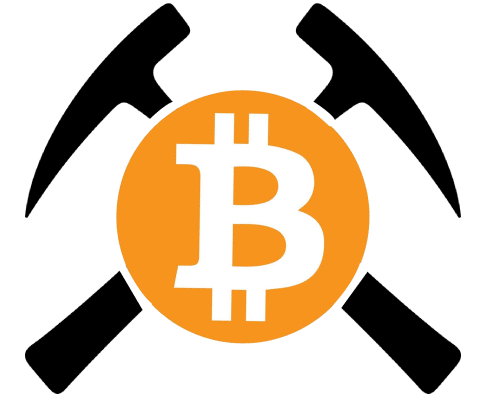
Let’s understand the bitcoin concept with an example. The company manager takes a dummy thing and announces that who will get this thing will be the happiest employer of the organization and get an international holiday ticket. So everyone trying to buy that dummy thing that has no value and in this way, this dummy thing will have some value may be lies between 10$ to 20$ or anything. We can relate these things with the Bitcoin if the number of purchasers of Bitcoin increases, then the value of Bitcoin also increases to a saturated value afterward it stops.
Bitcoin was created under the pseudonym(False name) Satoshi Nakamoto, who announced the invention, and later it was implemented as open-source code. An only end-to-end version of electronic money would enable online payments to be sent directly from one person to another without the interference of an economic body.Bitcoin is a network practice that empowers people to transfer assets rights on account units called Bitcoin’s, made in limited quantity. When an individual sends a couple of bitcoins to another individual, this data is communicated to the peer-to-peer bitcoin network.
This technology remains similar to purchasing something with virtual currency. However, one advantage of Bitcoins is that the arrangement remains unidentified. The personal identity of the sender and the beneficiary (receiver) remain encrypted. It is the primary reason that’s why it has become a trusted form of money transaction on the web. By convention, the complexity in making distributed money is the requirement for a proposal to avoid double-spending. One individual may simultaneously transmit two transactions, sending similar coins to two distinct parties on the network. Bitcoin settles this difficulty and ensures agreement of rights by keeping up a community ledger of all transactions, called the blockchain. New transactions are grouped mutually and are checked against the existing record to make sure all new communications are valid. Bitcoin’s accuracy is ensured by individuals who give computation authority to its system known as miners to validate and affix transactions to a public ledger.
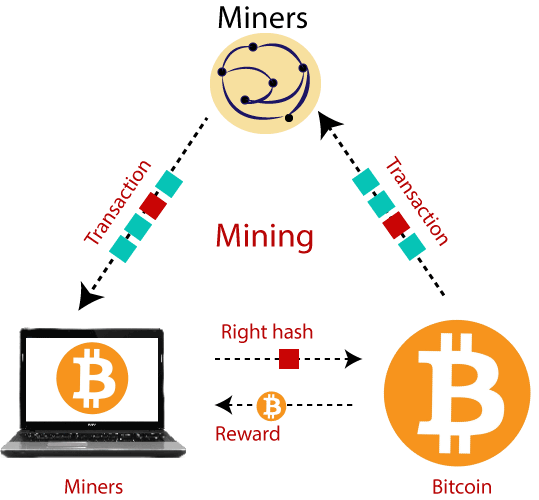
Bitcoins don’t exist physically and are only an arrangement of virtual data. It can be exchanged for genuine money, and are broadly acceptable in most countries around the globe. There is no central authority for Bitcoins, similar to a central bank(RBI in India) that controls the monetary policy. Alternatively, developers solve complex puzzles to support Bitcoin transactions. This process is called Bitcoin mining.
How to Mine Bitcoins:
It is quite a complex process, but if you want to take it directly, then here is the process of how it works. You need to get a CPU(Central Processing Unit) with excellent processing power and a speedy web interface. In the next step, there are numerous online networks that list out the latest Bitcoin transactions taking place in real-time. Afterward, Sign in with a Bitcoin customer and attempt to approve those transactions by assessing blocks of data, called hash. Now, communication goes through several systems, called nodes, which are simply blocks of data, and since the data is encoded, a miner is needed to check if his answers are accurate.
It is quite a complex process, but if you want to take it directly, then here is the process of how it works. You need to get a CPU(Central Processing Unit) with excellent processing power and a speedy web interface. In the next step, there are numerous online networks that list out the latest Bitcoin transactions taking place in real-time. Afterward, Sign in with a Bitcoin customer and attempt to approve those transactions by assessing blocks of data, called hash. Now, communication goes through several systems, called nodes, which are simply blocks of data, and since the data is encoded, a miner is needed to check if his answers are accurate.
How the Bitcoin Mining Works:
Bitcoin Mining requires a task that is exceptionally tricky to perform, but simple to verify. It uses cryptography, with a hash function called double SHA-256( a one-way function that converts a text of any dimension into a string of 256 bits). A hash accepts a portion of data as input and reduces it down into a smaller hash value (256 bits). With a cryptographic hash, there is no other option to get a hash value we want without attempting a ton of sources. Once we find an input that gives the value we want, it is a simple task for anybody to validate the hash. So, cryptographic hashing turns into a decent method to apply the Bitcoin “Proof-of-work” (data that is complex to produce but easy for others to verify).
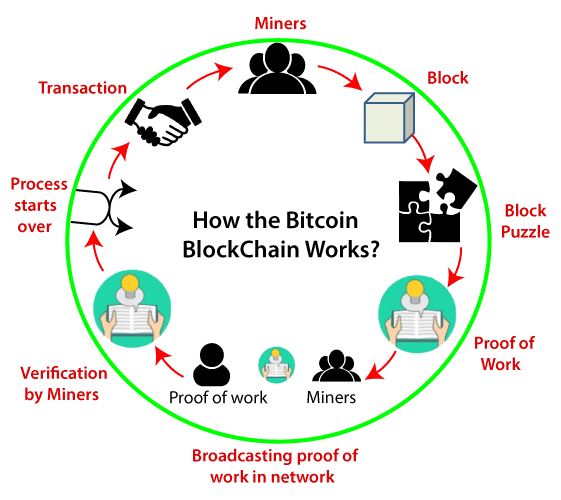
If we consider a block to mine first, we need to collect the new transactions into a block, and then we hash the block to form a 256-bit block hash value. When the hash initiates with sufficient zeros, the block has been successfully mined and is directed to the Bitcoin network, and that has turned into the identifier for the block. In many cases, the hash is not successful, so we need to alter the block to some extent and try again and again.
Bitcoin Transaction:
A Bitcoin transaction is a section of data that is transmitted to the network and, if valid, it ends up in a block in the blockchain. The concept of a Bitcoin transaction is to transfer the responsibility of an amount of Bitcoin address.
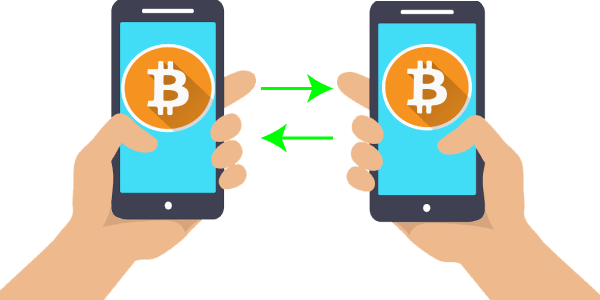
When we send Bitcoin, an individual data structure, namely a Bitcoin transaction, is made by your wallet customer and afterward communicate to rebroadcast the transaction. If the operation is valid, nodes will incorporate it in the block they are mining, within 10-20 minutes, the transaction will be included, along with other transactions, in a block in the blockchain. Finally, the receiver can see the transaction amount in their wallet.
Some facts about transactions:
- The Bitcoin amount that we send is always sent to a particular address.
- The Bitcoin amount we get is locked to the receiving address, which is associated with our wallet.
- Every time we spend Bitcoin, the amount we spend will consistently come from funds received earlier and currently present in our wallet.
- Addresses receive Bitcoin, but they don?t send Bitcoin, it is sent from a wallet.
Bitcoin Wallets:
Bitcoin wallets compile the private keys through which we access a bitcoin address and payout our funds. They appear in different forms, designed for specific types of devices. We can even use hardcopy to store data to avoid having them on the computer. It is important to secure and back up our Bitcoin wallet. Bitcoins are the latest technology of cash, and very soon, other merchants start accepting them as payment.
We know how a bitcoin transaction mechanism works and how they are created, but how they are stored? We store money in a physical wallet, and bitcoin works similarly, except it is generally digital. In brief, we don’t need to stock bitcoins anywhere. What we store are the secured digital keys used to access our public bitcoin address and sign transactions.
There are mainly five types of wallet that are given below:
Desktop Wallets:
First, we need to install the original bitcoin customer (Bitcoin Core). If we have already installed, then we are running a wallet, but may not know it. In addition to depend on transactions on the network, this software also empowers us to create a bitcoin address for transfer and getting the virtual currency. MultiBit(Bitcoin wallet) runs on Mac OSX, Windows, and Linux. Hive is an OS X- based wallet with some particular features, including an application store that associates directly to bitcoin services.
Mobile Wallets:
An application on our cell phone, the wallet can store up the security key for our bitcoin addresses, and enable us to pay for things straightforwardly with our phone. Many times, a bitcoin wallet will even take advantage of a cell phone?s near-field communication(NFC) aspect, empowering us to tap the mobile phone against a reader and pay bitcoins without entering any data at all. A bitcoin customer has to download the whole bitcoin blockchain, which is always developing and is multiple gigabytes in size. A ton of mobile phones wouldn’t be able to hold the blockchain in their memory. In such a case, they can use alternative options, and these mobile users are repeatedly designed with simplified payment verification (SPV) in mind. They download a confined subset of the blockchain and depend on other trusted nodes in the bitcoin system to ensure that they have the precise data. Mycelium is the example of mobile wallets that comprises of the Android-based Bitcoin wallet.
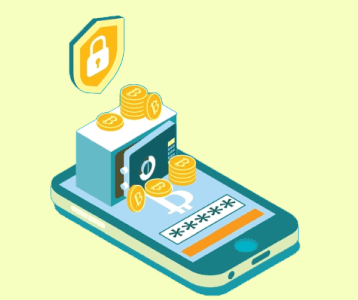
Online Wallets:
Electronic wallets stores our security keys on the web, on a computer, limited by someone else and coupled to the Internet. Various online services are accessible, and the network to mobile and desktop wallets copying our address among various devices that we own. One significant advantage of online wallets is that we can access them from anywhere, in spite of which device we are using.
Hardware Wallets:
Hardware wallets are incomplete numbers. These are sharp devices that can hold private keys electronically and make easy payments. The compact Ledger USB bitcoin Wallet utilizes smartcard protection and is accessible at a reasonable cost.
Paper Wallets:
The cheapest alternative for keeping our bitcoins safe and sound is significantly called a paper wallet. There are various sites offering paper bitcoin wallet services. They deliver a bitcoin address for us and generate an image containing two QR codes. The first one is the public address that we can use to receive bitcoins, and the other is the private key that we use to pay out bitcoins stored at the address. The primary advantage of a paper wallet is that the private keys are not stored digitally anyplace, so it secures our wallet from cyber attacks.
